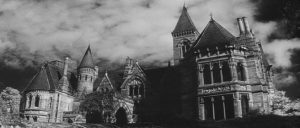I mentioned in my last post that I’d been reading Hilary Mantel’s memoir Giving Up the Ghost – do try and read it if you can.
When Hilary is six, the family moves into a haunted house. “Our daily life,” she says, “is hushed, driven into corners. We move in a rush between the house’s safe areas, and the ones less safe, where, as you enter a room, you get the impression that someone is waiting for you.”
When I read this, I was taken straight back to my own childhood and visits to my grandmother’s house. On the ground floor, a stained-glass paneled front door led into a dark passage, from which the front room, the stairs, the kitchen and the living room at the back of the house were accessed. There were also two doors which opened onto steps down into larder cupboards, one on either side of the kitchen door and at right angles to it, and you had to pass between these to get to the kitchen. I remember family Sunday lunches at grandma’s; afterwards, in winter, we would all gather in the living room in front of the fire to watch tv. But when you wanted to go to the loo, you had to leave this place of safety and run down the hallway and up the stairs and back again, as quickly as you could, because there was something behind those larder doors that was intent on catching you, and you could always feel it watching as you ran by.


